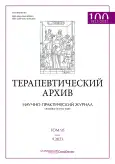Трудности дифференциальной диагностики AL- и ATTR-амилоидоза сердца
- Авторы: Орлов Ф.И.1, Аншелес А.А.1, Насонова С.Н.1, Саидова М.А.1, Жиров И.В.1,2, Степанова Е.А.2, Суворина М.Ю.3, Шошина А.А.1, Терещенко С.Н.1, Сергиенко В.Б.1
-
Учреждения:
- ФГБУ «Национальный медицинский исследовательский центр кардиологии имени акад. Е.И. Чазова» Минздрава России
- ФГБОУ ДПО «Российская медицинская академия непрерывного профессионального образования» Минздрава России
- ФГБУН «Институт белка» РАН
- Выпуск: Том 95, № 9 (2023)
- Страницы: 789-795
- Раздел: Клинические наблюдения
- URL: https://journals.rcsi.science/0040-3660/article/view/254695
- DOI: https://doi.org/10.26442/00403660.2023.09.202376
- ID: 254695
Цитировать
Полный текст
Аннотация
В статье представлен клинический случай, описывающий трудности дифференциальной диагностики типов амилоидоза сердца и верификации диагноза AL-амилоидоза.
Ключевые слова
Полный текст
Открыть статью на сайте журналаОб авторах
Филипп Игоревич Орлов
ФГБУ «Национальный медицинский исследовательский центр кардиологии имени акад. Е.И. Чазова» Минздрава России
Автор, ответственный за переписку.
Email: feelorlove@gmail.com
ORCID iD: 0000-0003-2866-7141
ResearcherId: HKV-3361-2023
лаборант исследователь, отдел радионуклидной диагностики и позитронно-эмиссионной томографии
Россия, МоскваАлексей Аркадьевич Аншелес
ФГБУ «Национальный медицинский исследовательский центр кардиологии имени акад. Е.И. Чазова» Минздрава России
Email: a.ansheles@gmail.com
ORCID iD: 0000-0002-2675-3276
доктор медицинских наук, старший научный сотрудник отделения радионуклидной диагностики и позитронно-эмиссионной томографии
Россия, МоскваСветлана Николаевна Насонова
ФГБУ «Национальный медицинский исследовательский центр кардиологии имени акад. Е.И. Чазова» Минздрава России
Email: feelorlove@gmail.com
ORCID iD: 0000-0002-0920-7417
доктор медицинских наук, профессор, руководитель отделения ультразвуковых методов исследования
Россия, МоскваМарина Абдулатиповна Саидова
ФГБУ «Национальный медицинский исследовательский центр кардиологии имени акад. Е.И. Чазова» Минздрава России
Email: feelorlove@gmail.com
ORCID iD: 0000-0002-3233-1862
доктор медицинских наук, профессор, руководитель отделения ультразвуковых методов исследования
Россия, МоскваИгорь Витальевич Жиров
ФГБУ «Национальный медицинский исследовательский центр кардиологии имени акад. Е.И. Чазова» Минздрава России; ФГБОУ ДПО «Российская медицинская академия непрерывного профессионального образования» Минздрава России
Email: dr.nasonova@mail.ru
ORCID iD: 0000-0002-4066-2661
доктор медицинских наук, вед. научный сотрудник отделения заболеваний миокарда и сердечной недостаточности ФГБУ «НМИЦ кардиологии имени акад. Е.И. Чазова», профессор кафедры кардиологии ФГБОУ ДПО РМАНПО
Россия, Москва; МоскваЕлена Александровна Степанова
ФГБОУ ДПО «Российская медицинская академия непрерывного профессионального образования» Минздрава России
Email: feelorlove@gmail.com
ORCID iD: 0000-0001-7760-5858
ассистент кафедры патологической анатомии
Россия, МоскваМария Юрьевна Суворина
ФГБУН «Институт белка» РАН
Email: feelorlove@gmail.com
ORCID iD: 0000-0001-7058-4310
мл. научный сотрудник лаборатории биоинформатических и протеомных исследований
Россия, ПущиноАнастасия Александровна Шошина
ФГБУ «Национальный медицинский исследовательский центр кардиологии имени акад. Е.И. Чазова» Минздрава России
Email: feelorlove@gmail.com
ORCID iD: 0000-0002-9519-7373
аспирант отделения заболеваний миокарда и сердечной недостаточности
Россия, МоскваСергей Николаевич Терещенко
ФГБУ «Национальный медицинский исследовательский центр кардиологии имени акад. Е.И. Чазова» Минздрава России
Email: feelorlove@gmail.com
ORCID iD: 0000-0001-9234-6129
доктор медицинских наук, профессор, руководитель отделения заболеваний миокарда и сердечной недостаточности
Россия, МоскваВладимир Борисович Сергиенко
ФГБУ «Национальный медицинский исследовательский центр кардиологии имени акад. Е.И. Чазова» Минздрава России
Email: feelorlove@gmail.com
ORCID iD: 0000-0002-0487-6902
доктор медицинских наук, профессор, руководитель отделения радионуклидной диагностики и позитронно-эмиссионной томографии
Россия, МоскваСписок литературы
- Buxbaum JN, Dispenzieri A, Eisenberg DS, et al. Amyloid nomenclature 2022: update, novel proteins, and recommendations by the International Society of Amyloidosis (ISA) Nomenclature Committee. Amyloid. 2022;29(4):213-9. doi: 10.1080/13506129.2022.2147636
- Dubrey SW, Hawkins PN, Falk RH. Amyloid diseases of the heart: Assessment, diagnosis, and referral. Heart. 2011;97(1):75-84. doi: 10.1136/hrt.2009.190405
- Siddiqi OK, Ruberg FL. Cardiac amyloidosis: An update on pathophysiology, diagnosis, and treatment. Trends Cardiovasc Med. 2018;28(1):10-21. doi: 10.1016/j.tcm.2017.07.004
- Adams D, Suhr OB, Hund E, et al. First European consensus for diagnosis, management, and treatment of transthyretin familial amyloid polyneuropathy. Curr Opin Neurol. 2016;29:S14-26. doi: 10.1097/WCO.0000000000000289
- Falk RH, Alexander KM, Liao R, Dorbala S. AL (Light-Chain) Cardiac Amyloidosis: A Review of Diagnosis and Therapy. J Am Coll Cardiol. 2016;68(12):1323-41. doi: 10.1016/j.jacc.2016.06.053
- Ryšavá R. AL amyloidosis: advances in diagnostics and treatment. Nephrol Dial Transplant. 2019;34(9):1460-6. doi: 10.1093/ndt/gfy291
- Palladini G, Milani P, Merlini G. Management of AL amyloidosis in 2020. Blood. 2020;136(23):2620-7. doi: 10.1182/blood.2020006913
- Rubin J, Maurer MS. Cardiac Amyloidosis: Overlooked, Underappreciated, and Treatable. Annu Rev Med. 2020;71:203-19. doi: 10.1146/annurev-med-052918-020140
- Dittrich T, Kimmich C, Hegenbart U, Schönland SO. Prognosis and Staging of AL Amyloidosis. Acta Haematol. 2020;143(4):388-400. doi: 10.1159/000508287
- Сергиенко В.Б., Терещенко С.Н., Аншелес А.А., и др. Радионуклидные методы в диагностике амилоидоза сердца. Рациональная фармакотерапия в кардиологии. 2018;14(1):94-100 [Sergienko VB, Tereshchenko SN, Ansheles AA, et al. Nuclear imaging in the diagnosis of cardiac amyloidosis. Rational Pharmacotherapy in Cardiology. 2018;14(1):94-100 (in Russian)]. doi: 10.20996/1819-6446-2018-14-1-94-100
- Martinez-Naharro A, Hawkins PN, Fontana M. Cardiac amyloidosis. Clin Med (Lond). 2018;18(Suppl. 2):s30-s35. doi: 10.7861/clinmedicine.18-2-s30
- Zeng Y, Poterucha TJ, Einstein AJ, et al. False positive technetium-99m pyrophosphate scintigraphy in a patient with cardiac amyloidosis light chain: Case report. Medicine (Baltimore). 2021;100(17):e25582. doi: 10.1097/MD.0000000000025582
Дополнительные файлы












